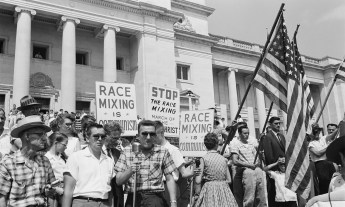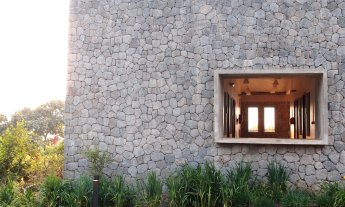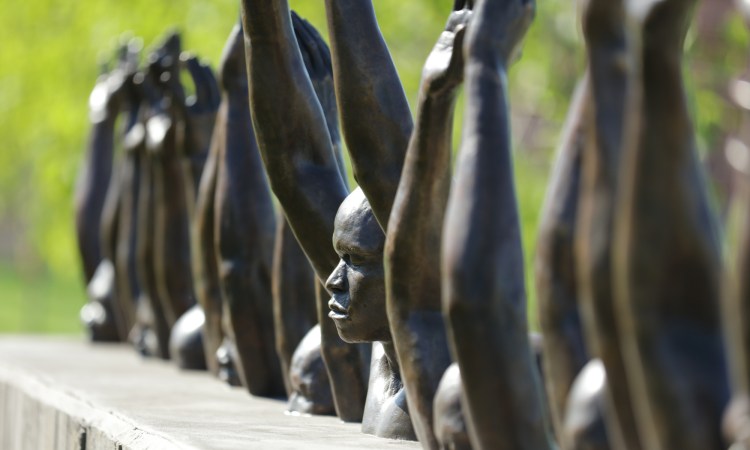
Architect John Cary traveled to Montgomery, Alabama, for the opening of the National Memorial to Peace & Justice, which recognizes the estimated 4,300 lynchings that have occurred in this country. He shares his impressions of the powerful monument to racial violence.
On April 23, 2018, the state of Alabama celebrated “Confederate Memorial Day.” Yup, you’ve got that right: while controversy over the removal of Confederate flags and statues continues to make national news, Alabama is one of several states in America that continues to dedicate an official holiday to the Confederacy. The capital in Montgomery and public services throughout the state closed down for the occasion, as they do every year.
But all is not business as usual. Barely 72 hours later in Montgomery, the nonprofit Equal Justice Initiative (EJI) officially opened the National Memorial to Peace & Justice, a six-acre site and monument to lynching in America. Poignantly, the memorial stands in the shadow of the capital building steps, where, in 1963, Governor George Wallace declared, “Segregation now, segregation tomorrow, segregation forever.” It’s also where, two years later, the historic civil rights march from Selma to Montgomery concluded.
An architect by training, I’ve spent the past decade exploring and writing about the ways in which design can dignify. Whether sitting in a man’s exquisitely simple and safe home after he lived through decades of housing insecurity here in America or watching women on the brink of giving birth gather together in a maternity waiting village created expressly for them in Malawi — I’ve felt the dignifying power of design in my bones. I believe the built environment truly can help people heal. Bricks and mortar are not just about construction; they are, if we do it right, about transformation. So it was with great anticipation that I went to experience the memorial firsthand last week.
Montgomery is home to EJI as well as its founder: civil rights attorney and author Bryan Stevenson (TED Talk: We need to talk about an injustice). For years, on top of their work to end mass incarceration and excessive punishment, Stevenson and his staff meticulously documented the more than 4,300 lynchings that took place across the US, concentrated largely in the American South between 1877 and 1950.
After reading an article about EJI’s research in 2015, architect Michael Murphy approached Stevenson about the possibility of helping him memorialize the atrocities of lynching. Murphy is the cofounder of the social justice architecture firm MASS Design Group, a unique nonprofit specializing in buildings that heal, broadly defined. I watched Murphy’s TED Talk (Architecture that’s built to heal) in 2016, which introduced the concept of the memorial, and I’ve followed the project’s progress over the last few years. Still, what I found on my arrival exceeded even my wildest expectations.
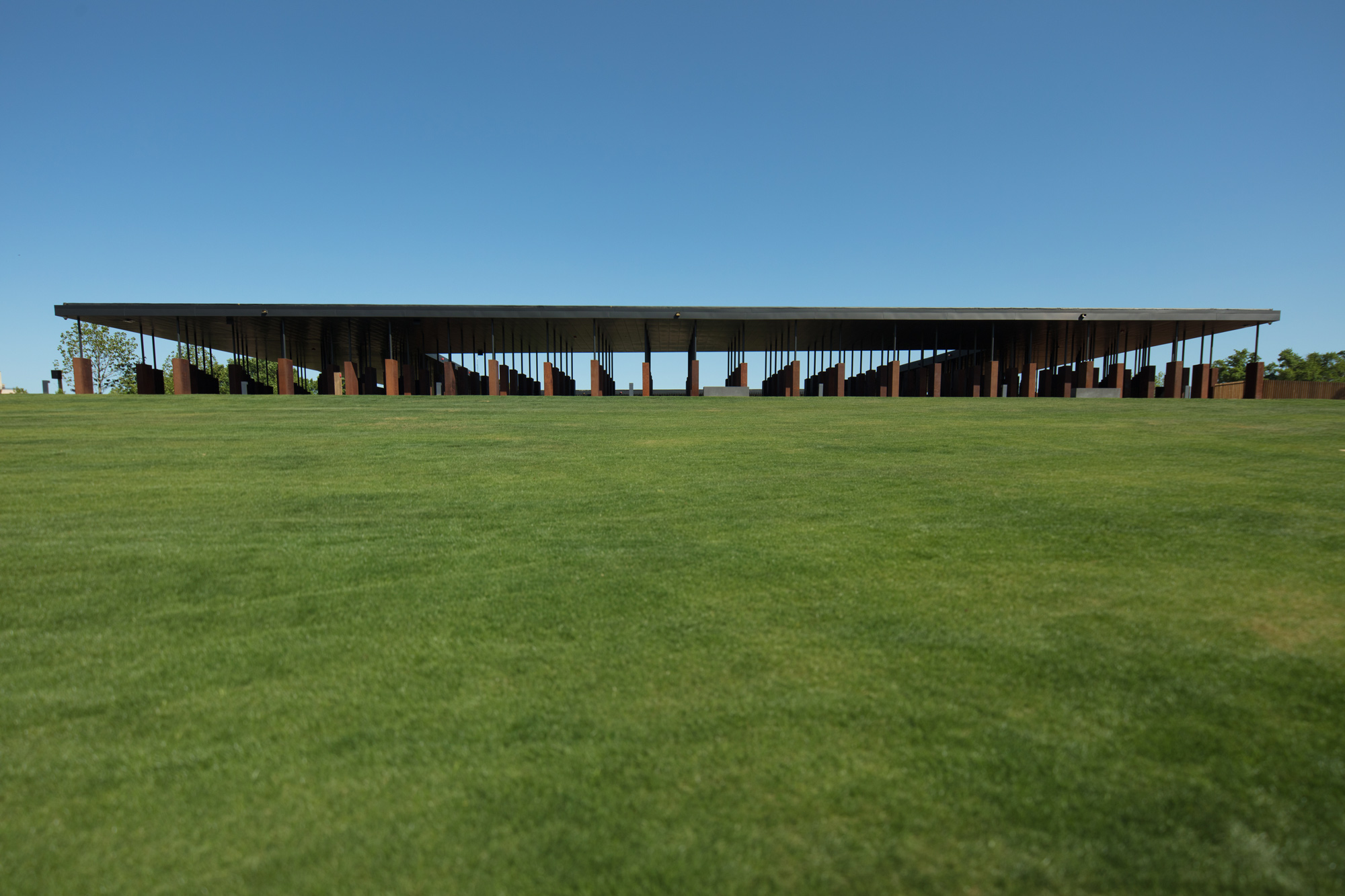
Entering the memorial site, which is located on a hilltop overlooking Montgomery, I start my journey along a fine gravel path where I am quickly greeted by a trio of plaques with words that explain the intent of the memorial and its roots in slavery. I stand in horror in front of a gut-wrenching sculpture (shown below) by Ghanaian artist Kwame Akoto-Bamfo, which depicts a group of men, women and children chained together, their bodies and faces in excruciating pain, and captures the transatlantic slave trade that laid the groundwork for lynching. The gravel path continues, then turns upwards toward the actual memorial structure at the top of the site.
When I enter the first corridor of the four-sided structure, I immediately come face to face with what appear to be standard floor-to-ceiling columns. Spaced perhaps five feet apart from one another, each six-foot tall column is marked with a county and state, along with the name or names of those who were lynched there — anywhere from one to dozens of people.
Most people’s conversations abruptly stop or quiet to a whisper when they walk into the memorial.
As I pause there, trying to take it all in, I hear the footsteps of other visitors on the wooden plank floor echo off the rusted steel columns. I watch as countless visitors stop and trace the outlines of the first few names with their fingers. The memorial contains 800 columns in total, bearing the names of some 4,300 people. Although the earlier plaques and sculpture set a solemn tone, the memorial structure itself heightens the level of reverence — most people’s conversations abruptly stop or quiet to a whisper when they walk in. This is sacred ground.
By the time you reach the end of that first corridor — which is more than 125 feet in length — it becomes clear that the columns are not actually affixed to the ground. The names, which began at waist level, rise to eye level as the space between the column bases and the floor increases. Then, when you turn and start down the second side of the memorial, the bases of the columns rise to eye level and they’re soon overhead, the small letters of the names still decipherable. It’s at that moment when the columns most clearly evoke black bodies hanging as they once did from tree branches, in public squares and elsewhere. Even though symbolic, it’s a startling and unthinkable sight — the hundreds upon hundreds of columns and thousands of names, bodies, lives.
A security guard, named Deshawn, stands as I and countless visitors audibly gasp at what is being revealed before us. African-American and an Army brat in his mid-20s, Deshawn and his family moved frequently from state to state due to his father’s deployments, but he calls Montgomery “home.” He tells me, “This place is beautiful. I remember when I used to come by here when I was little, and the land had a bunch of abandoned apartments. To see it replaced with something like this is amazing.”
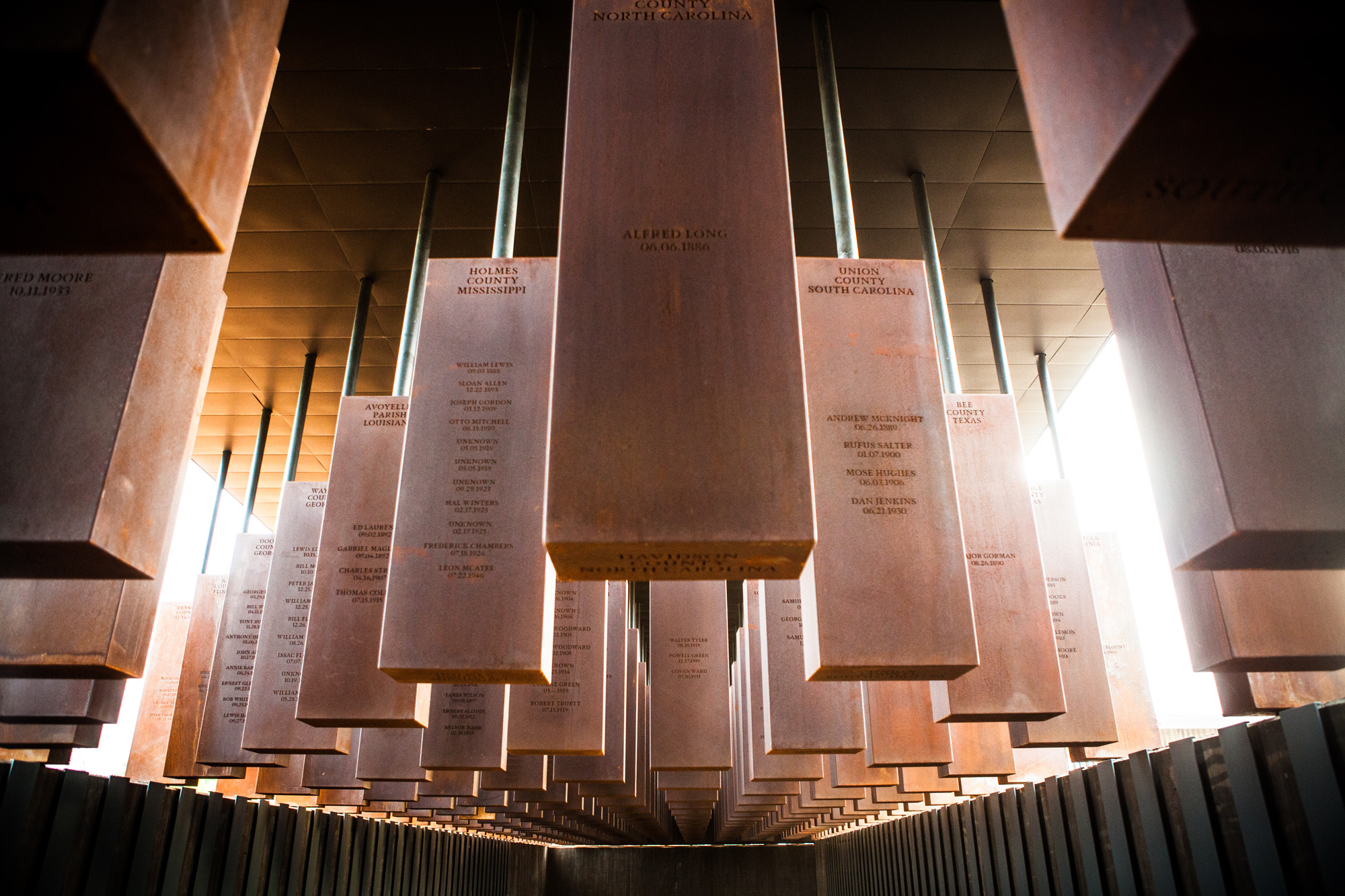
Deshawn is stationed looking down the length of the third corridor, where the density and number of columns dramatically increases, triggering our involuntary gasps. Hanging well above our heads, with the county names still readily legible and the people’s names less so, the columns present a truly staggering sight. Closer to ground level, a row of vertical metal plates line the walls at right and left — each with a brutally simple, single sentence at the bottom to tell the story of lynchings. The small white letters of one plate read: “David Walker, his wife, and their four children were lynched in Hickman, Kentucky, in 1908 after Mr. Walker was accused of using inappropriate language with a white woman.”
Near the end of that third corridor, following the metal plates, a large inscription authored by EJI reads: “For the hanged and beaten. For the shot, drowned, and burned. For the tortured, tormented, and terrorized. For those abandoned by the rule of law. We will remember. With hope because hopelessness is the enemy of justice. With courage because peace requires bravery. With persistence because justice is a constant struggle. With faith because we shall overcome.”
The material palette of the memorial is remarkably simple — the hanging steel columns, the rough concrete walls showing the outlines of its wooden formwork that molded the walls, and the wooden plank floor. As a final grand gesture, a sheet of water rushes down the perimeter wall for the entire length of the 127-footlong corridor.
At the end of that fourth corridor, visitors can either turn right to walk up into an open air courtyard at the center of the memorial, or left to exit the structure. There, duplicates of the hanging columns — each with the names of counties, states, and victims — rest horizontally, like coffins. Whereas the interior columns don’t appear to be in any particular order, the coffins outside are alphabetized by state, aiding visitors who are seeking out specific locations.
The coffins rest in a sort of purgatory, waiting to be claimed by each county, which EJI has set up a process to facilitate. The counties are expected to display the columns in a public space and acknowledge the terror that took place there. Already, inquiries have reportedly come from several dozen counties.
Rather than intellectualizing the terror of lynchings as has been done over the decades, the memorial physicalizes it.
Among the many people milling about the coffins is Laurel Blatchford, a white woman who heads a national housing and community development organization. She had brought one of her daughters, a fifth grader, from their home in Washington, DC, to experience the memorial. Together, they sought out counties in nearby Virginia as part of a school project to make up the time away.
“I had to see this, and I wanted my daughter to,” Blatchford explains. “We think and talk about these issues a fair amount, always working to bring them into our work in a meaningful way, specifically around racial equity. There are lots of tools to pursue these goals, but this experience seeing the memorial is a hundred times more powerful.”
It’s a sentiment that I ended up hearing numerous times and share — there is really nothing to compare the memorial to, though many people mention Maya Lin’s iconic Vietnam Veterans Memorial in Washington, DC. The lynching memorial’s sheer scale, the magnitude of human suffering that it represents, and the resulting experience of journeying through it are almost beyond words. Rather than intellectualizing the terror of lynchings as has been done in writing, photos, and films over the decades, the memorial physicalizes it. I literally feel like a witness to the thousands of lynchings.
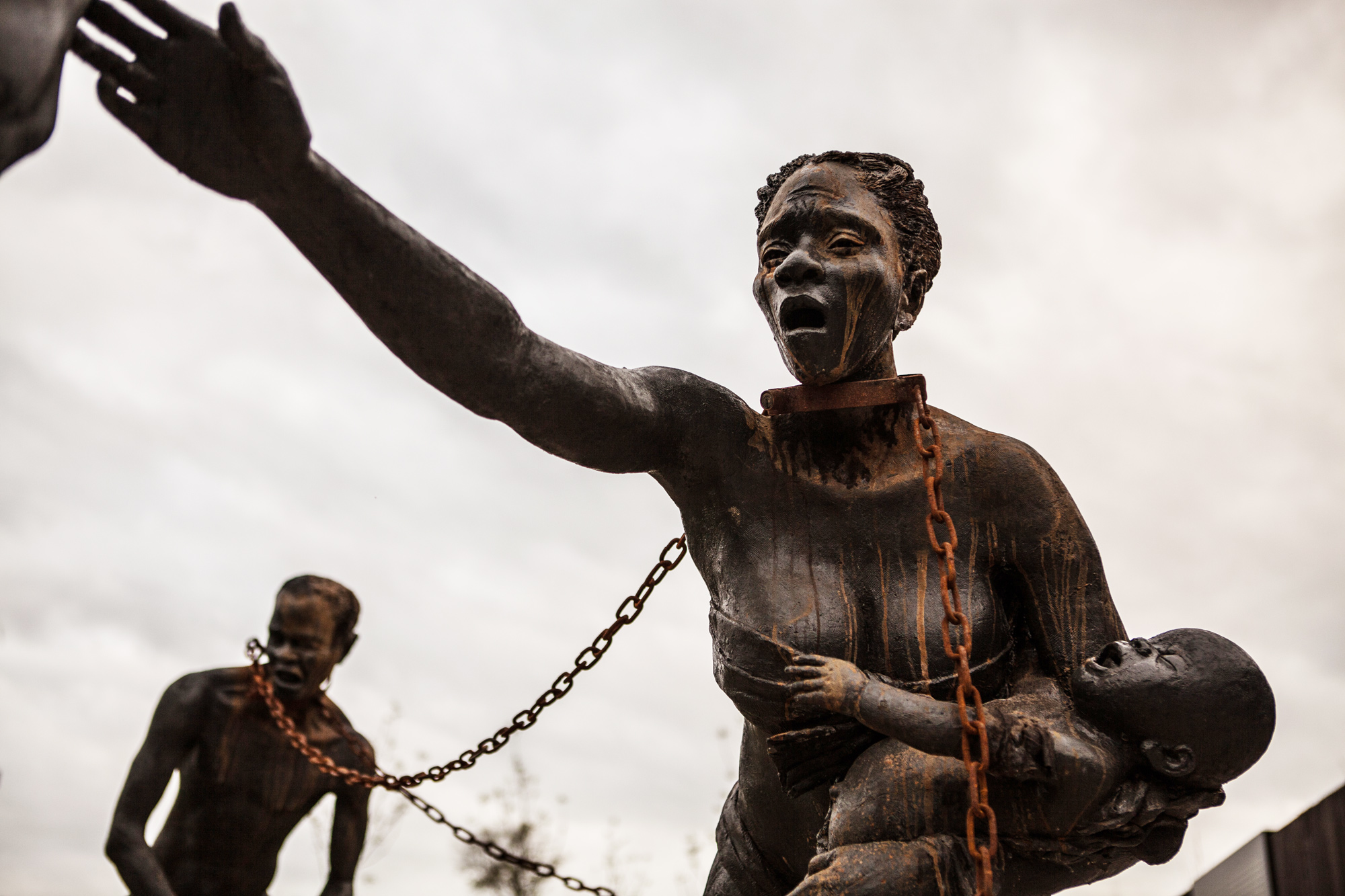
The memorial also breaks ground by naming and honoring — in many cases for the first time — the thousands of African-American people who were robbed of their lives. Along with its sister site, The Legacy Museum, the memorial may be a place of healing for descendants of those lynched, but Stevenson hopes it’s also an important step toward the US acknowledging the collective trauma of lynching in the way Germany has sought to do with the Holocaust and South Africa has with Apartheid.
Whereas the memorial is symbolic, The Legacy Museum — roughly a 15-minute walk into the heart of downtown Montgomery (shown below) — is comprehensive and explicit, drawing a clear line between slavery, lynchings and mass incarceration. The museum, designed by NYC-based Local Projects (which is led by Jake Barton [Talk: The museum of you] ) in partnership with EJI, warrants a multi-hour visit. It’s emotionally taxing, appropriately so, to absorb the graphic photos of lynchings in the public square, grainy films of civil rights movement protests, and handwritten letters from juvenile inmates struggling to survive in adult prisons. Among the museum pieces are an installation by artist and TED Fellow Sanford Biggers (Talk: An artist’s unflinching look at racial violence) and a breathtaking sculpture by Titus Kaphar (Talk: Can art amend history?).
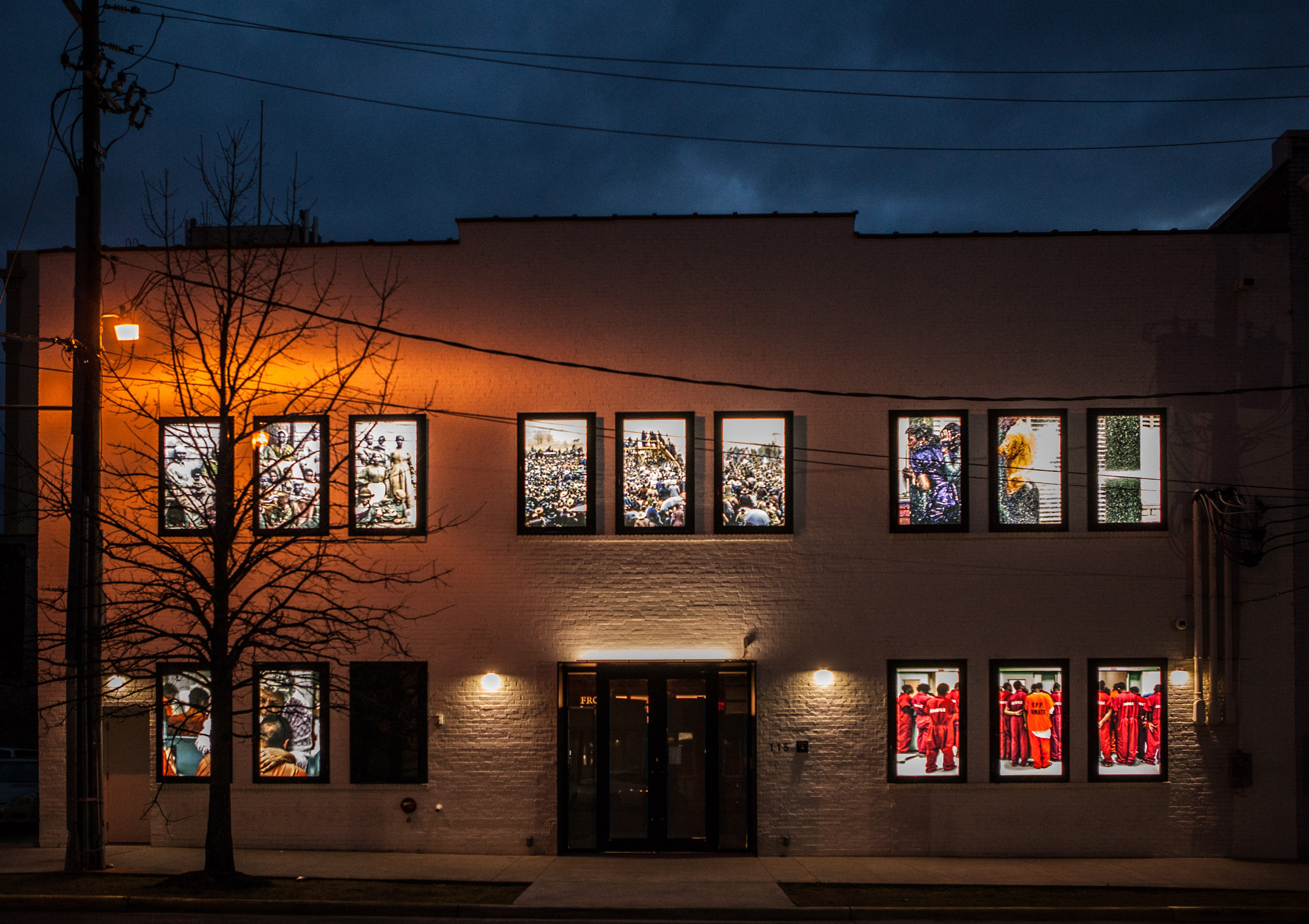
Back at the memorial, I meet a graying man named Larry Peterson, as he pauses near the end of the long water feature in the final corridor. African-American and the father of two, Peterson is a 26-year military veteran and retired from a long career in public service as a park ranger. He looks youthful, wearing a black stocking cap, light gray sweat suit, white T-shirt, and bright orange running shoes. “This place is somewhat personal to me, being a son of the south,” he says. “My family was from a county that was notorious for keeping African-Americans in their ‘place’ by using tactics like lynching. There are really two types of lynching: you’ve got this physical type, but also the psychological type.”
Peterson explains he learned from his father that even the slightest thing could mean the difference between living and lynching, life and death. He refers to his dad multiple times as we speak; I wonder what the memorial might have meant to him. Judging from the cracks in his voice to the tears in his tired eyes, it’s clear to me that this place deeply moves Peterson. Throughout our conversation, he has one ear bud in. He tells me he was listening to Billie Holiday’s “Strange Fruit” on repeat as he took it all in.
















